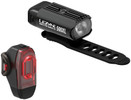What to Look For In A Bicycle Light
3rd Apr 2020
Bicycle lights have come a long way with dozens of features. There are now literally hundreds of lights on the market and it can be a bit hard to navigate what to look for. We will break down it down for you.
- Lumens- Almost all lights will list the number of lumens they put out. A lumen is approximately the light of a birthday candle and 750 lumens equals the light of a 60 watt light bulb. Rear lights will start with as few as 7 lumens and front lights over 1500. They key question is whether or not you are using the light as a daytime light for increased visibility or actually riding at dusk or in the dark. There is no big downside to more lumens; more is more visible.
- Front/Rear- I believe everyone should have a rear light for daytime use. It is a small investment that greatly increases your visibility. A rider using a flashing rear light is far more visible than one without. If you are riding at dusk or at night you will want a rear light with much more power (lumens). You don't necessarily need a front light if you ride mainly in the day but many front lights are so small and compact it is good insurance if you get caught out at dusk. I mention dusk a lot because this is actually when visibility is the worst and accidents occur the most. If you are actually riding at night, such as commuting, you will want a headlight that has at least 1000 lumens.
- Side Marker Lights- Relatively new side lights increase visibility in situations like crossing in front of traffic at an intersection. There is no downside to more visibility and many accidents do occur in this situation. Think of it as added insurance.
- Features- Some lights come with so many features, modes, and are even programmable that it can be overwhelming. The important thing to note is all those modes actually serve a purpose- flashing for daytime visibility, higher output for night time, battery saving mode, increased side visibility, etc.. Some offer a battery indicator which is real important if you are worried about your light going dead before you make it home. You can switch to a lower power mode which still offers visibility with longer battery life. A tail light with a decelerometer is essentially a brake light which is highly useful in group rides. Warning that jackass looking at his smart phone while drafting you may be just what you need. The point is to choose a light with enough modes for the conditions you ride in.
- LED's- The number of LED bulbs matters. The more bulbs, the more visibility and some bulbs serve specific purposes such as side visibility. A light with a single LED can only serve a few purposes whereas a light with multiple bulbs can serve many.
- USB Rechargeable- This is somewhat redundant in that most lights are USB rechargeable now but look for an integrated cable. This means you don't have to go searching through that drawer to find the right charge cable.
- Water Resistant/Proof- Most lights are water resistant to some extent but may not hold up in the rain. Better lights meet the IPX7 which means it can be immersed in water up to 1 meter; more than you need. IPX5 means it will meet water jets in any direction. You want a minimum of IPX5.
- Integrations- Some lights can be app programmed into a lighting system. This may seem like a bit of overkill but custom programming for your specific needs might just be what you are looking for. Garmin makes a the Varia radar system that warns you of oncoming traffic.
- Mounting- Many lights use a simple rubber strap that allows you to attach it just about anywhere. This versatility allows you to put it on your seatpost, frame bag, or even helmet. It also allows you to move the light around to where it is needed.
Hopefully this breaks things down for you a bit. As far as brands, the ones we sell that have had the fewest warranty issues are Lezyne, Kryptonite, Knog, Topeak, and Garmin.


